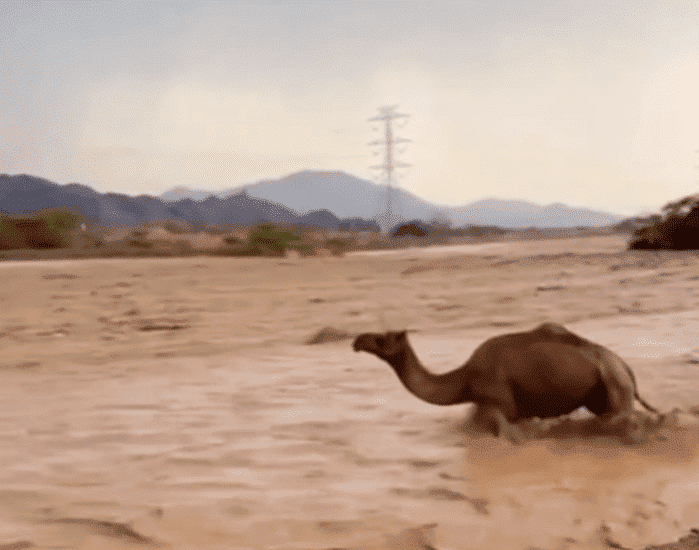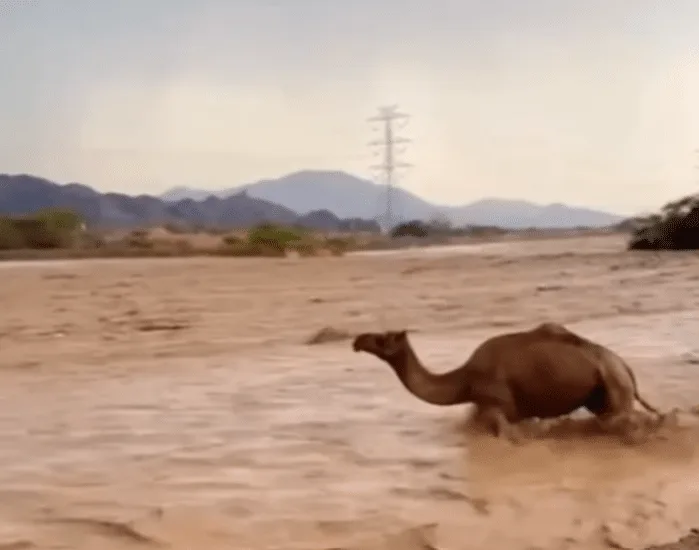Introduction
Saudi Arabia, known for its vast deserts and arid landscapes, experienced a stark contrast recently as it grappled with devastating floods. During the summer, Saudi Arabia is marked by scorching temperatures, often soaring as high as 122°F (50°C), and minimal rain. However, during the monsoon (May to November) season, Southern Saudi Arabia in particular, receives a surprisingly large amount of rain. Flash floods can occur in desert terrain when intense rainfall fails to be absorbed by the arid sands, potentially posing serious threats when encountering swift, rising waters. Regrettably, in these events, camels, integral to the region’s culture and economy, often find themselves caught in the torrents, with some tragically unable to survive.

Natural Hazards
As per data from the Climate Change Knowledge Portal, floods in Saudi Arabia account for 44 percent of natural hazards affecting human populations. The video illustrates one such flood incident, depicting a helpless camel caught in the torrents. In a desperate struggle for survival, the camel battles to reach higher ground, but the relentless floodwaters ultimately sweep it away, leaving only its head and hump protruding above the water.
The Arabian Camel
The dromedary, scientifically known as Camelus dromedarius, is a remarkable species of camel native to arid regions of Africa and the Middle East. These distinctive creatures are renowned for their single hump, which stores fat reserves that provide them with sustenance during long journeys through the desert. Dromedaries have played a crucial role in the history and culture of the regions they inhabit. With their adaptability to harsh desert environments and impressive stamina, these camels remain vital to the livelihoods of many communities, offering transportation, milk, meat, and wool.
Climate change
Climate change disrupts traditional weather patterns, leading to prolonged droughts followed by heavy rainfall, creating a recipe for catastrophic floods. The impact on humans and their livestock during floods can be catastrophic.
Actions individuals can take to reduce their influence on climate change:
- Conserve Energy: Use energy-efficient appliances and lighting, insulate homes, and turn off electronics when not in use.
- Switch to Renewable Energy: Consider solar panels and support clean energy initiatives.
- Reduce, Reuse, Recycle: Minimize waste, choose products with less packaging, and recycle and compost.
- Sustainable Transportation: Use public transit, carpool, or bike, and opt for fuel-efficient or electric vehicles.
- Sustainable Food Choices: Reduce meat consumption, minimize food waste, and support sustainable agriculture.
- Plant Trees: Support reforestation and maintain green spaces.
- Vote for Climate-Friendly Policies: Support candidates and policies that prioritize climate action.
These actions empower individuals to make a positive impact on climate change and foster a more sustainable future.
You might also enjoy:
A Heartfelt Reunion Uniting Rescuer and Rhino Orphan
Camouflaged Hippo Gives Curious Leopard a Fright
A New Pangolin Species Discovery Renews Hope
Join our Forum for free today!

- The Bond Between a Wild Baby Bison and Her Rescuer - July 20, 2024
- An Excited Husky’s First Ever Time in Snow - July 20, 2024
- Top 20 Colorful Species To Brighten Your Day - July 14, 2024


